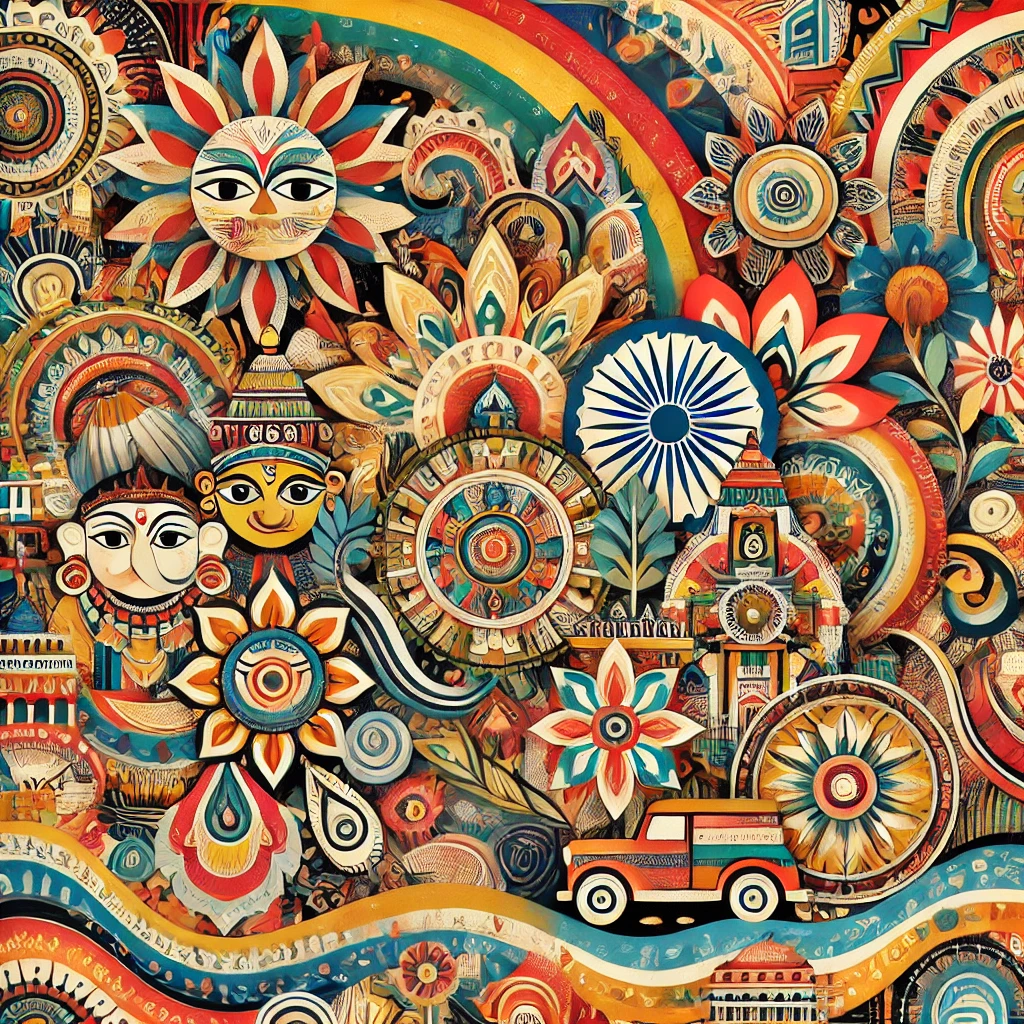Work on reviving disappearing Indian Traditional Art Form. These unique and ancient styles are slowly fading, yet they hold deep cultural and historical value. By showcasing them, we can preserve India’s artistic heritage and support talented artists.
For centuries, artists have created stunning paintings, sculptures, and crafts that narrate stories of history, religion, and daily life. However, many Indian Traditional Art Forms are slowly vanishing. Due to modernization, mass production, and a lack of support, artists struggle to sustain their traditions.
In this blog, we will highlight the Top 10 Indian Traditional Art Form at risk of disappearing. Additionally, we will explore ways to help, preserve them, and support the artisans who keep these traditions alive.
1. Madhubani Painting (Bihar)

Why Indian Traditional Art Form Disappearing:
How to Save Our Precious Indian Traditional Art Form
Buying handmade Madhubani paintings instead of printed versions.
Supporting artists through online platforms like Kalaspot
2. Warli Art (Maharashtra)
Warli painting originated from the Warli tribe of Maharashtra, India, and stands out as a beautiful Indian Traditional Art Form. Featuring simple yet expressive white stick figures on a mud-based background, this tribal art has been preserved and passed down through generations.
More than just a painting style, Warli art acts as a visual storytelling tradition, vividly portraying daily life, nature, festivals, and rituals. Furthermore, while it continues to evolve, it retains its deep cultural significance.
In this blog, let’s delve into the history, unique features, and modern relevance of this remarkable Indian Traditional Art Form.

Why It’s Disappearing:
People prefer modern home décor, so Warli paintings have fewer buyers.
Fake digital prints have reduced demand for real hand-painted Warli art.
How to Save It:
3. Pattachitra (Odisha & West Bengal)
Pattachitra painting stands out as a renowned Indian traditional art form, known for its detailed mythological themes, intricate borders, and vibrant colors. Emerging from Odisha and West Bengal, skilled artisans have practiced this art for centuries. Moreover, by passing down their techniques through generations, they have actively preserved this rich artistic tradition.

The word “Pattachitra” derives from two Sanskrit words:
Patta – meaning cloth or canvas
Chitra – meaning painting
Dating back over 1,000 years, this Indian traditional art form maintains a deep connection to Hindu temples and religious rituals. Originating in Odisha, particularly around the Jagannath Temple in Puri, artisans painted stories of Lord Jagannath, Krishna, and other deities, keeping alive the region’s spiritual and artistic traditions.
Similarly, in West Bengal, a related tradition thrives, where storytelling artists called Patuas create scroll paintings (known as “Patua” art) and narrate mythological tales through their artwork.
Why It’s Disappearing:
Cheap machine-made paintings have significantly reduced the demand for hand-painted Pattachitra.
Consequently, only a few skilled artists continue to practice this traditional art form.
How to Save It:
4. Rogan Art (Gujarat)

Phad painting emerged from Rajasthan, India, as a unique and vibrant Indian traditional art form. Known for its detailed storytelling, mythological themes, and bold colors, this painting style significantly contributes to India’s cultural heritage.
Why It’s Disappearing:
1 Very few artists are skilled in this technique.
2 Lack of awareness about this art.
How to Save It:
1 Supporting Rogan artists by buying their handmade fabrics.
2 Promoting awareness about this unique art form.
5. Phad Painting (Rajasthan
Phad painting originated in Rajasthan, India, as a unique and vibrant Indian traditional art form. Renowned for its detailed storytelling, mythological themes, and bold colors, this painting style holds a significant place in India’s cultural heritage.

Phad painting originated over 700 years ago, with the Joshi community of Rajasthan developing this unique Indian traditional art form. Initially, artists created large cloth scrolls as portable temples, which traveling storytellers, called Bhopas, carried to villages. Through these scrolls, they vividly depicted Hindu deities and epic tales, particularly the stories of Pabuji and Devnarayan, revered as local folk deities.
Moreover, Phad painting played a crucial role in folk performances, allowing Bhopas to sing and narrate stories while simultaneously pointing to different sections of the artwork. As a result, they brought these legendary tales to life, preserving the tradition for generations.
Why It’s Disappearing:
1 Fewer people are interested in storytelling traditions.
2 Artists struggle to make a living from this art.
How to Save It:
1 Buying Phad paintings from authentic artists.
2 Encouraging artists to sell online for better income.
6. Thanjavur Painting (Tamil Nadu)

This artwork beautifully depicts the divine bond between young Krishna and his mother, Yashoda, showcasing the rich detailing that defines Thanjavur paintings.
Emerging in the 16th century under the rule of the Nayak and Maratha kings of Thanjavur (Tanjore), Thanjavur painting flourished in the temple town, which served as a major center for art, culture, and religion. Inspired by their surroundings, artists actively created divine paintings of Hindu gods and saints.
With the support of the Chola dynasty, Vijayanagar rulers, and Maratha kings, this Indian traditional art form developed its distinctive style. Even today, skilled artists continue to preserve and practice this timeless artistic tradition.
Why It’s Disappearing
1 The high cost of materials like gold foil makes it expensive to create.
2 Printed copies of Thanjavur paintings have reduced the demand for originals.
How to Save It:
1 Educating buyers about the value of real hand-painted Thanjavur art.
2 Supporting artisans who still practice this art.
7. Chittara Art (Karnataka)
Chittara painting is a rare and intricate Indian traditional art form practiced by the Deevaru community of Karnataka, India. Known for its geometric patterns, natural colors, and cultural significance, Chittara art is an essential part of South India’s folk traditions.

Chittara painting is an ancient folk art that has been practiced for centuries by the Deevaru women of Karnataka. Traditionally, these paintings were drawn on the walls of houses during festivals, weddings, and special occasions to bring prosperity and happiness.
The word “Chittara” means “drawing” or “design”, and these paintings are deeply connected to tribal traditions, rituals, and nature.
Unlike other Indian traditional art forms, Chittara painting is not just for decoration—it represents harmony, fertility, and divine blessings.
Why It’s Disappearing:
1 Young artists are moving to cities for better jobs.
2 There is less demand for traditional wall paintings.
How to Save It:
1 Encouraging Chittara artists to adapt their designs for modern home décor.
2 Promoting Chittara art through workshops and exhibitions.
8. Saura Painting (Odisha)

Saura painting, also known as Ikons or Idital, is a tribal art form practiced by the Saura tribe of Odisha, one of India’s oldest indigenous communities.
Traditionally, artists drew these paintings on the walls of village homes during festivals, weddings, and religious ceremonies to honor deities, ancestors, and nature. Believing in their spiritual powers, the Saura people use these paintings to protect their homes from evil forces and to bring prosperity.
Unlike many other Indian traditional art forms, Saura painting holds deep religious significance, serving as both a medium of storytelling and a form of worship.
Why It’s Disappearing:
1 Limited recognition outside Odisha.
2 Fewer artists practicing this art form.
How to Save It:
1 Promoting Saura art through online platforms and social media.
2 Buying authentic Saura paintings instead of machine-made copies.
9. Manjusha Art (Bihar)

Manjusha painting originated in the Anga region of Bihar, particularly in Bhagalpur, and dates back to the medieval period. Traditionally, artisans painted these artworks on boxes (Manjusha) made of bamboo, jute, and paper—hence the name “Manjusha,” meaning box or container.
Closely linked to the Bihula-Bishari legend, this Indian traditional Painting depicts a mythological tale of faith and devotion to Goddess Manasa (Bishari), the serpent goddess.
Historically, communities practiced Manjusha art during festivals as an act of worship. Over time, artisans transformed it into a recognized folk painting style, keeping its cultural significance alive.
Why It’s Disappearing:
It is not as popular as Madhubani art; consequently, fewer artists practice it due to a lack of awareness and demand.
How to Save It:
Spreading awareness about this beautiful art.
Additionally, supporting Manjusha artists by buying their paintings.
10. Kalamkari (Andhra Pradesh & Telangana)

The word “Kalamkari” comes from two Persian words:
“Kalam” meaning pen
“Kari” meaning work
This Indian traditional art form dates back over 3,000 years, with artists originally using it to depict religious stories on temple cloths and scrolls. Later, it flourished under the Golconda Sultanate and Mughal era, gaining royal patronage.
Kalamkari painting features two main styles:
- Srikalahasti Style – Artists hand-paint intricate patterns using a pen (kalam) made from bamboo.
- Machilipatnam Style – Artisans use wooden blocks to imprint floral and mythological motifs through block-printing.
Historically, artists decorated temple walls, narrated epic stories, and designed royal clothing with this Indian traditional art form. Even today, they continue to preserve its legacy through meticulous craftsmanship.
Why It’s Disappearing:
Machine-printed fabrics are replacing handmade Kalamkari.
How to Save These Indian Traditional Art Form:
Choosing hand-painted Kalamkari fabrics over machine-made ones.
Moreover, encouraging sustainable fashion that supports traditional textile art.
Conclusion: How We Can Help to Save These Indian Traditional Art
What Can We Do to Increase The Passion of Indian Traditional Art Form






